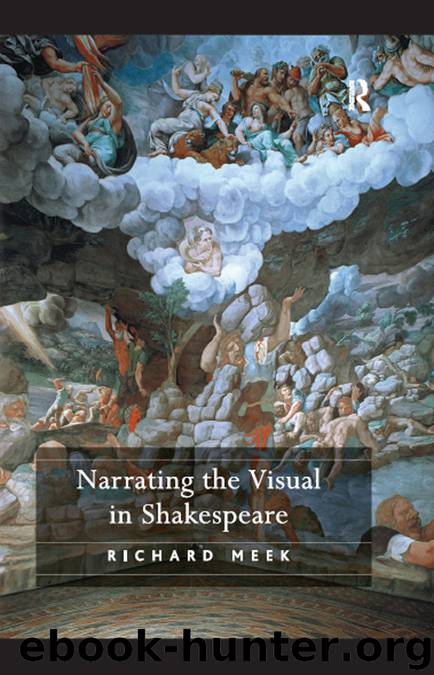Narrating the Visual in Shakespeare by Meek Richard;

Author:Meek, Richard;
Language: eng
Format: epub
Publisher: Routledge
Notes
1 Unless otherwise stated, quotations from Hamlet are taken from Ann Thompson and Neil Taylor’s Arden 3 edition (London: Thomson Learning, 2006). This edition is based on the Second Quarto (Q2). Among the many treatments of the metatheatrical aspects of the play see especially Anne Righter [Barton], Shakespeare and the Idea of the Play, esp. pp. 158–64, and her ‘Introduction’ to the New Penguin edition of Hamlet, ed. T.J.B. Spencer (Harmondsworth: Penguin, 1980); James L. Calderwood, To Be and Not to Be: Negation and Metadrama in ‘Hamlet’ (New York: Columbia University Press, 1983); Robert Weimann, ‘Mimesis in Hamlet’, in Patricia Parker and Geoffrey H. Hartman (eds), Shakespeare and the Question of Theory (London: Methuen, 1985), pp. 275–91, and Author’s Pen and Actor’s Voice, chs 1 and 6; and Bruce Danner, ‘Speaking Daggers’, Shakespeare Quarterly, 54 (2003), 29–62.
2 For a thoughtful reading of Hamlet in the context of artistic ‘perspective’ and other aesthetic developments in the early modern period see Thorne, Vision and Rhetoric, ch. 4. Thorne comments briefly on Claudius’ painting simile, and suggests that ‘the play leaves us unsure of the extent to which any artificial construction – be it that of poet or painter – can capture the inward being it purports to resemble’ (p. 111).
3 Michael Neill, Issues of Death: Mortality and Identity in English Renaissance Drama (Oxford: Clarendon Press, 1997), p. 218.
4 See Alan R. Young, ‘Hamlet’ and the Visual Arts, 1709–1900 (Newark: University of Delaware Press, 2002). Young points to ‘the rich variety of visual images derived from the play’ (p. 11), but goes on to note that artists who have responded to the play ‘by no means confined themselves to the scenes in Shakespeare’s text that were familiar to theatregoers’ (p. 287). Thompson and Taylor suggest that Ophelia’s death – one of the play’s most significant descriptions of an offstage event – was one of the most frequently illustrated moments of the play, even before Millais’s painting (see their note to 4.7.164–81). See also Martha C. Ronk, ‘Representations of Ophelia’, Criticism, 36 (1994), 21–43; Kaara Peterson, ‘Framing Ophelia: Representation and the Pictorial Tradition’, Mosaic, 31 (1998), 1–24; and Adrian Poole, Shakespeare and the Victorians (London: Thomas Nelson, 2004), pp. 67–9. For an attractive and wide-ranging collection of pictorial responses to Shakespeare see Jane Martineau et al. (eds), Shakespeare in Art (London and New York: Merrell, 2003).
5 Krieger, ‘Representation as Illusion: Dramatic Representation and the Natural-Sign Aesthetic’, in Ekphrasis, ch. 4 (p. 56). While Krieger does not discuss Shakespeare explicitly in this discussion of dramatic representation, he does use Hamlet’s advice to the players (‘Suit the action to the word, the word to the action …’) as the epigraph to the chapter (see p. 31).
6 See Barthes, S/Z: ‘they are so many fragments of something that has always been already read, seen, done, experienced; the code is the wake of that already’ (p. 20).
7 Terence Hawkes has noted how ‘Subsequence, posteriority, these are the effective modes of the opening’. He also calls attention to ‘the
Download
This site does not store any files on its server. We only index and link to content provided by other sites. Please contact the content providers to delete copyright contents if any and email us, we'll remove relevant links or contents immediately.
Call Me by Your Name by André Aciman(19900)
Ready Player One by Cline Ernest(13979)
How to Be a Bawse: A Guide to Conquering Life by Lilly Singh(7154)
Wiseguy by Nicholas Pileggi(5315)
The Kite Runner by Khaled Hosseini(4951)
On Writing A Memoir of the Craft by Stephen King(4662)
Audition by Ryu Murakami(4612)
The Crown by Robert Lacey(4572)
Call me by your name by Andre Aciman(4463)
Gerald's Game by Stephen King(4373)
Harry Potter and the Cursed Child: The Journey by Harry Potter Theatrical Productions(4314)
Dialogue by Robert McKee(4160)
The Perils of Being Moderately Famous by Soha Ali Khan(4064)
Dynamic Alignment Through Imagery by Eric Franklin(3919)
Apollo 8 by Jeffrey Kluger(3512)
How to be Champion: My Autobiography by Sarah Millican(3493)
The Inner Game of Tennis by W. Timothy Gallwey(3472)
Seriously... I'm Kidding by Ellen DeGeneres(3412)
Darker by E L James(3407)
